JUC锁 - Java 8 中 AbstractQueuedSynchronizer 源码解读分析
JUC锁 - Java 8 中 AbstractQueuedSynchronizer 源码解读分析
总体介绍
AbstractQueuedSynchronizer概述
在锁框架中,AbstractQueuedSynchronizer抽象类可以毫不夸张的说,占据着核心地位,它提供了一个基于FIFO队列,可以用于构建锁或者其他相关同步装置的基础框架。所以很有必要好好分析。
AbstractQueuedSynchronizer数据结构
分析类,首先就要分析底层采用了何种数据结构,抓住核心点进行分析,经过分析可知,AbstractQueuedSynchronizer类的数据结构如下
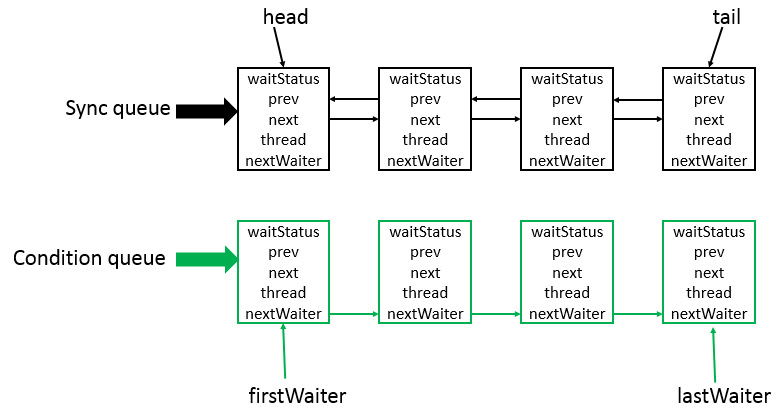
说明:AbstractQueuedSynchronizer类底层的数据结构是使用双向链表,是队列的一种实现,故也可看成是队列,其中Sync queue,即同步队列,是双向链表,包括head结点和tail结点,head结点主要用作后续的调度。而Condition queue不是必须的,其是一个单向链表,只有当使用Condition时,才会存在此单向链表。并且可能会有多个Condition queue。
AbstractQueuedSynchronizer源码分析
类的继承关系
public abstract class AbstractQueuedSynchronizer
extends AbstractOwnableSynchronizer
implements java.io.Serializable
说明:从类继承关系可知,AbstractQueuedSynchronizer继承自AbstractOwnableSynchronizer抽象类,并且实现了Serializable接口,可以进行序列化。而AbstractOwnableSynchronizer抽象类的源码如下
public abstract class AbstractOwnableSynchronizer
implements java.io.Serializable {
// 版本序列号
private static final long serialVersionUID = 3737899427754241961L;
// 构造函数
protected AbstractOwnableSynchronizer() { }
// 独占模式下的线程
private transient Thread exclusiveOwnerThread;
// 设置独占线程
protected final void setExclusiveOwnerThread(Thread thread) {
exclusiveOwnerThread = thread;
}
// 获取独占线程
protected final Thread getExclusiveOwnerThread() {
return exclusiveOwnerThread;
}
}
说明:AbstractOwnableSynchronizer抽象类中,可以设置独占资源线程和获取独占资源线程。分别为setExclusiveOwnerThread与getExclusiveOwnerThread方法,这两个方法会被子类调用。
类的内部类
AbstractQueuedSynchronizer类有两个内部类,分别为Node类与ConditionObject类。下面分别做介绍。
1、Node类
static final class Node {
// 模式,分为共享与独占
// 共享模式
static final Node SHARED = new Node();
// 独占模式
static final Node EXCLUSIVE = null;
// 结点状态
// CANCELLED,值为1,表示当前的线程被取消
// SIGNAL,值为-1,表示当前节点的后继节点包含的线程需要运行,也就是unpark
// CONDITION,值为-2,表示当前节点在等待condition,也就是在condition队列中
// PROPAGATE,值为-3,表示当前场景下后续的acquireShared能够得以执行
// 值为0,表示当前节点在sync队列中,等待着获取锁
static final int CANCELLED = 1;
static final int SIGNAL = -1;
static final int CONDITION = -2;
static final int PROPAGATE = -3;
// 结点状态
volatile int waitStatus;
// 前驱结点
volatile Node prev;
// 后继结点
volatile Node next;
// 结点所对应的线程
volatile Thread thread;
// 下一个等待者
Node nextWaiter;
// 结点是否在共享模式下等待
final boolean isShared() {
return nextWaiter == SHARED;
}
// 获取前驱结点,若前驱结点为空,抛出异常
final Node predecessor() throws NullPointerException {
// 保存前驱结点
Node p = prev;
if (p == null) // 前驱结点为空,抛出异常
throw new NullPointerException();
else // 前驱结点不为空,返回
return p;
}
// 无参构造函数
Node() { // Used to establish initial head or SHARED marker
}
// 构造函数
Node(Thread thread, Node mode) { // Used by addWaiter
this.nextWaiter = mode;
this.thread = thread;
}
// 构造函数
Node(Thread thread, int waitStatus) { // Used by Condition
this.waitStatus = waitStatus;
this.thread = thread;
}
}
说明:每个线程被阻塞的线程都会被封装成一个Node结点,放入队列。每个节点包含了一个Thread类型的引用,并且每个节点都存在一个状态,具体状态如下。
① CANCELLED,值为1,表示当前的线程被取消。
② SIGNAL,值为-1,表示当前节点的后继节点包含的线程需要运行,需要进行unpark操作。
③ CONDITION,值为-2,表示当前节点在等待condition,也就是在condition queue中。
④ PROPAGATE,值为-3,表示当前场景下后续的acquireShared能够得以执行。
⑤ 值为0,表示当前节点在sync queue中,等待着获取锁。
2、ConditionObject类
// 内部类
public class ConditionObject implements Condition, java.io.Serializable {
// 版本号
private static final long serialVersionUID = 1173984872572414699L;
/** First node of condition queue. */
// condition队列的头结点
private transient Node firstWaiter;
/** Last node of condition queue. */
// condition队列的尾结点
private transient Node lastWaiter;
/**
* Creates a new {@code ConditionObject} instance.
*/
// 构造函数
public ConditionObject() { }
// Internal methods
/**
* Adds a new waiter to wait queue.
* @return its new wait node
*/
// 添加新的waiter到wait队列
private Node addConditionWaiter() {
// 保存尾结点
Node t = lastWaiter;
// If lastWaiter is cancelled, clean out.
if (t != null && t.waitStatus != Node.CONDITION) { // 尾结点不为空,并且尾结点的状态不为CONDITION
// 清除状态为CONDITION的结点
unlinkCancelledWaiters();
// 将最后一个结点重新赋值给t
t = lastWaiter;
}
// 新建一个结点
Node node = new Node(Thread.currentThread(), Node.CONDITION);
if (t == null) // 尾结点为空
// 设置condition队列的头结点
firstWaiter = node;
else // 尾结点不为空
// 设置为节点的nextWaiter域为node结点
t.nextWaiter = node;
// 更新condition队列的尾结点
lastWaiter = node;
return node;
}
/**
* Removes and transfers nodes until hit non-cancelled one or
* null. Split out from signal in part to encourage compilers
* to inline the case of no waiters.
* @param first (non-null) the first node on condition queue
*/
private void doSignal(Node first) {
// 循环
do {
if ( (firstWaiter = first.nextWaiter) == null) // 该节点的nextWaiter为空
// 设置尾结点为空
lastWaiter = null;
// 设置first结点的nextWaiter域
first.nextWaiter = null;
} while (!transferForSignal(first) &&
(first = firstWaiter) != null); // 将结点从condition队列转移到sync队列失败并且condition队列中的头结点不为空,一直循环
}
/**
* Removes and transfers all nodes.
* @param first (non-null) the first node on condition queue
*/
private void doSignalAll(Node first) {
// condition队列的头结点尾结点都设置为空
lastWaiter = firstWaiter = null;
// 循环
do {
// 获取first结点的nextWaiter域结点
Node next = first.nextWaiter;
// 设置first结点的nextWaiter域为空
first.nextWaiter = null;
// 将first结点从condition队列转移到sync队列
transferForSignal(first);
// 重新设置first
first = next;
} while (first != null);
}
/**
* Unlinks cancelled waiter nodes from condition queue.
* Called only while holding lock. This is called when
* cancellation occurred during condition wait, and upon
* insertion of a new waiter when lastWaiter is seen to have
* been cancelled. This method is needed to avoid garbage
* retention in the absence of signals. So even though it may
* require a full traversal, it comes into play only when
* timeouts or cancellations occur in the absence of
* signals. It traverses all nodes rather than stopping at a
* particular target to unlink all pointers to garbage nodes
* without requiring many re-traversals during cancellation
* storms.
*/
// 从condition队列中清除状态为CANCEL的结点
private void unlinkCancelledWaiters() {
// 保存condition队列头结点
Node t = firstWaiter;
Node trail = null;
while (t != null) { // t不为空
// 下一个结点
Node next = t.nextWaiter;
if (t.waitStatus != Node.CONDITION) { // t结点的状态不为CONDTION状态
// 设置t节点的额nextWaiter域为空
t.nextWaiter = null;
if (trail == null) // trail为空
// 重新设置condition队列的头结点
firstWaiter = next;
else // trail不为空
// 设置trail结点的nextWaiter域为next结点
trail.nextWaiter = next;
if (next == null) // next结点为空
// 设置condition队列的尾结点
lastWaiter = trail;
}
else // t结点的状态为CONDTION状态
// 设置trail结点
trail = t;
// 设置t结点
t = next;
}
}
// public methods
/**
* Moves the longest-waiting thread, if one exists, from the
* wait queue for this condition to the wait queue for the
* owning lock.
*
* @throws IllegalMonitorStateException if {@link #isHeldExclusively}
* returns {@code false}
*/
// 唤醒一个等待线程。如果所有的线程都在等待此条件,则选择其中的一个唤醒。在从 await 返回之前,该线程必须重新获取锁。
public final void signal() {
if (!isHeldExclusively()) // 不被当前线程独占,抛出异常
throw new IllegalMonitorStateException();
// 保存condition队列头结点
Node first = firstWaiter;
if (first != null) // 头结点不为空
// 唤醒一个等待线程
doSignal(first);
}
/**
* Moves all threads from the wait queue for this condition to
* the wait queue for the owning lock.
*
* @throws IllegalMonitorStateException if {@link #isHeldExclusively}
* returns {@code false}
*/
// 唤醒所有等待线程。如果所有的线程都在等待此条件,则唤醒所有线程。在从 await 返回之前,每个线程都必须重新获取锁。
public final void signalAll() {
if (!isHeldExclusively()) // 不被当前线程独占,抛出异常
throw new IllegalMonitorStateException();
// 保存condition队列头结点
Node first = firstWaiter;
if (first != null) // 头结点不为空
// 唤醒所有等待线程
doSignalAll(first);
}
/**
* Implements uninterruptible condition wait.
* <ol>
* <li> Save lock state returned by {@link #getState}.
* <li> Invoke {@link #release} with saved state as argument,
* throwing IllegalMonitorStateException if it fails.
* <li> Block until signalled.
* <li> Reacquire by invoking specialized version of
* {@link #acquire} with saved state as argument.
* </ol>
*/
// 等待,当前线程在接到信号之前一直处于等待状态,不响应中断
public final void awaitUninterruptibly() {
// 添加一个结点到等待队列
Node node = addConditionWaiter();
// 获取释放的状态
int savedState = fullyRelease(node);
boolean interrupted = false;
while (!isOnSyncQueue(node)) { //
// 阻塞当前线程
LockSupport.park(this);
if (Thread.interrupted()) // 当前线程被中断
// 设置interrupted状态
interrupted = true;
}
if (acquireQueued(node, savedState) || interrupted) //
selfInterrupt();
}
/*
* For interruptible waits, we need to track whether to throw
* InterruptedException, if interrupted while blocked on
* condition, versus reinterrupt current thread, if
* interrupted while blocked waiting to re-acquire.
*/
/** Mode meaning to reinterrupt on exit from wait */
private static final int REINTERRUPT = 1;
/** Mode meaning to throw InterruptedException on exit from wait */
private static final int THROW_IE = -1;
/**
* Checks for interrupt, returning THROW_IE if interrupted
* before signalled, REINTERRUPT if after signalled, or
* 0 if not interrupted.
*/
private int checkInterruptWhileWaiting(Node node) {
return Thread.interrupted() ?
(transferAfterCancelledWait(node) ? THROW_IE : REINTERRUPT) :
0;
}
/**
* Throws InterruptedException, reinterrupts current thread, or
* does nothing, depending on mode.
*/
private void reportInterruptAfterWait(int interruptMode)
throws InterruptedException {
if (interruptMode == THROW_IE)
throw new InterruptedException();
else if (interruptMode == REINTERRUPT)
selfInterrupt();
}
/**
* Implements interruptible condition wait.
* <ol>
* <li> If current thread is interrupted, throw InterruptedException.
* <li> Save lock state returned by {@link #getState}.
* <li> Invoke {@link #release} with saved state as argument,
* throwing IllegalMonitorStateException if it fails.
* <li> Block until signalled or interrupted.
* <li> Reacquire by invoking specialized version of
* {@link #acquire} with saved state as argument.
* <li> If interrupted while blocked in step 4, throw InterruptedException.
* </ol>
*/
// // 等待,当前线程在接到信号或被中断之前一直处于等待状态
public final void await() throws InterruptedException {
if (Thread.interrupted()) // 当前线程被中断,抛出异常
throw new InterruptedException();
// 在wait队列上添加一个结点
Node node = addConditionWaiter();
//
int savedState = fullyRelease(node);
int interruptMode = 0;
while (!isOnSyncQueue(node)) {
// 阻塞当前线程
LockSupport.park(this);
if ((interruptMode = checkInterruptWhileWaiting(node)) != 0) // 检查结点等待时的中断类型
break;
}
if (acquireQueued(node, savedState) && interruptMode != THROW_IE)
interruptMode = REINTERRUPT;
if (node.nextWaiter != null) // clean up if cancelled
unlinkCancelledWaiters();
if (interruptMode != 0)
reportInterruptAfterWait(interruptMode);
}
/**
* Implements timed condition wait.
* <ol>
* <li> If current thread is interrupted, throw InterruptedException.
* <li> Save lock state returned by {@link #getState}.
* <li> Invoke {@link #release} with saved state as argument,
* throwing IllegalMonitorStateException if it fails.
* <li> Block until signalled, interrupted, or timed out.
* <li> Reacquire by invoking specialized version of
* {@link #acquire} with saved state as argument.
* <li> If interrupted while blocked in step 4, throw InterruptedException.
* </ol>
*/
// 等待,当前线程在接到信号、被中断或到达指定等待时间之前一直处于等待状态
public final long awaitNanos(long nanosTimeout)
throws InterruptedException {
if (Thread.interrupted())
throw new InterruptedException();
Node node = addConditionWaiter();
int savedState = fullyRelease(node);
final long deadline = System.nanoTime() + nanosTimeout;
int interruptMode = 0;
while (!isOnSyncQueue(node)) {
if (nanosTimeout <= 0L) {
transferAfterCancelledWait(node);
break;
}
if (nanosTimeout >= spinForTimeoutThreshold)
LockSupport.parkNanos(this, nanosTimeout);
if ((interruptMode = checkInterruptWhileWaiting(node)) != 0)
break;
nanosTimeout = deadline - System.nanoTime();
}
if (acquireQueued(node, savedState) && interruptMode != THROW_IE)
interruptMode = REINTERRUPT;
if (node.nextWaiter != null)
unlinkCancelledWaiters();
if (interruptMode != 0)
reportInterruptAfterWait(interruptMode);
return deadline - System.nanoTime();
}
/**
* Implements absolute timed condition wait.
* <ol>
* <li> If current thread is interrupted, throw InterruptedException.
* <li> Save lock state returned by {@link #getState}.
* <li> Invoke {@link #release} with saved state as argument,
* throwing IllegalMonitorStateException if it fails.
* <li> Block until signalled, interrupted, or timed out.
* <li> Reacquire by invoking specialized version of
* {@link #acquire} with saved state as argument.
* <li> If interrupted while blocked in step 4, throw InterruptedException.
* <li> If timed out while blocked in step 4, return false, else true.
* </ol>
*/
// 等待,当前线程在接到信号、被中断或到达指定最后期限之前一直处于等待状态
public final boolean awaitUntil(Date deadline)
throws InterruptedException {
long abstime = deadline.getTime();
if (Thread.interrupted())
throw new InterruptedException();
Node node = addConditionWaiter();
int savedState = fullyRelease(node);
boolean timedout = false;
int interruptMode = 0;
while (!isOnSyncQueue(node)) {
if (System.currentTimeMillis() > abstime) {
timedout = transferAfterCancelledWait(node);
break;
}
LockSupport.parkUntil(this, abstime);
if ((interruptMode = checkInterruptWhileWaiting(node)) != 0)
break;
}
if (acquireQueued(node, savedState) && interruptMode != THROW_IE)
interruptMode = REINTERRUPT;
if (node.nextWaiter != null)
unlinkCancelledWaiters();
if (interruptMode != 0)
reportInterruptAfterWait(interruptMode);
return !timedout;
}
/**
* Implements timed condition wait.
* <ol>
* <li> If current thread is interrupted, throw InterruptedException.
* <li> Save lock state returned by {@link #getState}.
* <li> Invoke {@link #release} with saved state as argument,
* throwing IllegalMonitorStateException if it fails.
* <li> Block until signalled, interrupted, or timed out.
* <li> Reacquire by invoking specialized version of
* {@link #acquire} with saved state as argument.
* <li> If interrupted while blocked in step 4, throw InterruptedException.
* <li> If timed out while blocked in step 4, return false, else true.
* </ol>
*/
// 等待,当前线程在接到信号、被中断或到达指定等待时间之前一直处于等待状态。此方法在行为上等效于:awaitNanos(unit.toNanos(time)) > 0
public final boolean await(long time, TimeUnit unit)
throws InterruptedException {
long nanosTimeout = unit.toNanos(time);
if (Thread.interrupted())
throw new InterruptedException();
Node node = addConditionWaiter();
int savedState = fullyRelease(node);
final long deadline = System.nanoTime() + nanosTimeout;
boolean timedout = false;
int interruptMode = 0;
while (!isOnSyncQueue(node)) {
if (nanosTimeout <= 0L) {
timedout = transferAfterCancelledWait(node);
break;
}
if (nanosTimeout >= spinForTimeoutThreshold)
LockSupport.parkNanos(this, nanosTimeout);
if ((interruptMode = checkInterruptWhileWaiting(node)) != 0)
break;
nanosTimeout = deadline - System.nanoTime();
}
if (acquireQueued(node, savedState) && interruptMode != THROW_IE)
interruptMode = REINTERRUPT;
if (node.nextWaiter != null)
unlinkCancelledWaiters();
if (interruptMode != 0)
reportInterruptAfterWait(interruptMode);
return !timedout;
}
// support for instrumentation
/**
* Returns true if this condition was created by the given
* synchronization object.
*
* @return {@code true} if owned
*/
final boolean isOwnedBy(AbstractQueuedSynchronizer sync) {
return sync == AbstractQueuedSynchronizer.this;
}
/**
* Queries whether any threads are waiting on this condition.
* Implements {@link AbstractQueuedSynchronizer#hasWaiters(ConditionObject)}.
*
* @return {@code true} if there are any waiting threads
* @throws IllegalMonitorStateException if {@link #isHeldExclusively}
* returns {@code false}
*/
// 查询是否有正在等待此条件的任何线程
protected final boolean hasWaiters() {
if (!isHeldExclusively())
throw new IllegalMonitorStateException();
for (Node w = firstWaiter; w != null; w = w.nextWaiter) {
if (w.waitStatus == Node.CONDITION)
return true;
}
return false;
}
/**
* Returns an estimate of the number of threads waiting on
* this condition.
* Implements {@link AbstractQueuedSynchronizer#getWaitQueueLength(ConditionObject)}.
*
* @return the estimated number of waiting threads
* @throws IllegalMonitorStateException if {@link #isHeldExclusively}
* returns {@code false}
*/
// 返回正在等待此条件的线程数估计值
protected final int getWaitQueueLength() {
if (!isHeldExclusively())
throw new IllegalMonitorStateException();
int n = 0;
for (Node w = firstWaiter; w != null; w = w.nextWaiter) {
if (w.waitStatus == Node.CONDITION)
++n;
}
return n;
}
/**
* Returns a collection containing those threads that may be
* waiting on this Condition.
* Implements {@link AbstractQueuedSynchronizer#getWaitingThreads(ConditionObject)}.
*
* @return the collection of threads
* @throws IllegalMonitorStateException if {@link #isHeldExclusively}
* returns {@code false}
*/
// 返回包含那些可能正在等待此条件的线程集合
protected final Collection<Thread> getWaitingThreads() {
if (!isHeldExclusively())
throw new IllegalMonitorStateException();
ArrayList<Thread> list = new ArrayList<Thread>();
for (Node w = firstWaiter; w != null; w = w.nextWaiter) {
if (w.waitStatus == Node.CONDITION) {
Thread t = w.thread;
if (t != null)
list.add(t);
}
}
return list;
}
}
说明:此类实现了Condition接口,Condition接口定义了条件操作规范,具体如下:
public interface Condition {
// 等待,当前线程在接到信号或被中断之前一直处于等待状态
void await() throws InterruptedException;
// 等待,当前线程在接到信号之前一直处于等待状态,不响应中断
void awaitUninterruptibly();
//等待,当前线程在接到信号、被中断或到达指定等待时间之前一直处于等待状态
long awaitNanos(long nanosTimeout) throws InterruptedException;
// 等待,当前线程在接到信号、被中断或到达指定等待时间之前一直处于等待状态。此方法在行为上等效于:awaitNanos(unit.toNanos(time)) > 0
boolean await(long time, TimeUnit unit) throws InterruptedException;
// 等待,当前线程在接到信号、被中断或到达指定最后期限之前一直处于等待状态
boolean awaitUntil(Date deadline) throws InterruptedException;
// 唤醒一个等待线程。如果所有的线程都在等待此条件,则选择其中的一个唤醒。在从 await 返回之前,该线程必须重新获取锁。
void signal();
// 唤醒所有等待线程。如果所有的线程都在等待此条件,则唤醒所有线程。在从 await 返回之前,每个线程都必须重新获取锁。
void signalAll();
}
说明:Condition接口中定义了await、signal函数,用来等待条件、释放条件。之后会详细分析CondtionObject的源码。
类的属性
public abstract class AbstractQueuedSynchronizer
extends AbstractOwnableSynchronizer
implements java.io.Serializable {
// 版本号
private static final long serialVersionUID = 7373984972572414691L;
// 头结点
private transient volatile Node head;
// 尾结点
private transient volatile Node tail;
// 状态
private volatile int state;
// 自旋时间
static final long spinForTimeoutThreshold = 1000L;
// Unsafe类实例
private static final Unsafe unsafe = Unsafe.getUnsafe();
// state内存偏移地址
private static final long stateOffset;
// head内存偏移地址
private static final long headOffset;
// state内存偏移地址
private static final long tailOffset;
// tail内存偏移地址
private static final long waitStatusOffset;
// next内存偏移地址
private static final long nextOffset;
// 静态初始化块
static {
try {
stateOffset = unsafe.objectFieldOffset
(AbstractQueuedSynchronizer.class.getDeclaredField("state"));
headOffset = unsafe.objectFieldOffset
(AbstractQueuedSynchronizer.class.getDeclaredField("head"));
tailOffset = unsafe.objectFieldOffset
(AbstractQueuedSynchronizer.class.getDeclaredField("tail"));
waitStatusOffset = unsafe.objectFieldOffset
(Node.class.getDeclaredField("waitStatus"));
nextOffset = unsafe.objectFieldOffset
(Node.class.getDeclaredField("next"));
} catch (Exception ex) { throw new Error(ex); }
}
}
说明:属性中包含了头结点head,尾结点tail,状态state、自旋时间spinForTimeoutThreshold,还有AbstractQueuedSynchronizer抽象的属性在内存中的偏移地址,通过该偏移地址,可以获取和设置该属性的值,同时还包括一个静态初始化块,用于加载内存偏移地址。
类的构造函数
protected AbstractQueuedSynchronizer() { }
说明:此类构造函数为从抽象构造函数,供子类调用。
类的核心函数
1、acquire函数
该函数以独占模式获取(资源),忽略中断,即线程在aquire过程中,中断此线程是无效的。源码如下
public final void acquire(int arg) {
if (!tryAcquire(arg) &&
acquireQueued(addWaiter(Node.EXCLUSIVE), arg))
selfInterrupt();
}
由上述源码可以知道,当一个线程调用acquire时,调用方法流程如下。
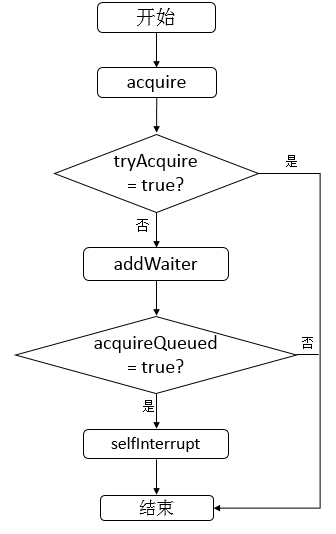
说明:
① 首先调用tryAcquire函数,调用此方法的线程会试图在独占模式下获取对象状态。此方法应该查询是否允许它在独占模式下获取对象状态,如果允许,则获取它。在AbstractQueuedSynchronizer源码中默认会抛出一个异常,即需要子类去重写此函数完成自己的逻辑。之后会进行分析。
② 若tryAcquire失败,则调用addWaiter函数,addWaiter函数完成的功能是将调用此方法的线程封装成为一个结点并放入Sync queue。
③ 调用acquireQueued函数,此函数完成的功能是Sync queue中的结点不断尝试获取资源,若成功,则返回true,否则,返回false。
由于tryAcquire默认实现是抛出异常,所以此时,不进行分析,之后会结合一个例子进行分析。
首先分析addWaiter函数
// 添加等待者
private Node addWaiter(Node mode) {
// 新生成一个结点,默认为独占模式
Node node = new Node(Thread.currentThread(), mode);
// Try the fast path of enq; backup to full enq on failure
// 保存尾结点
Node pred = tail;
if (pred != null) { // 尾结点不为空,即已经被初始化
// 将node结点的prev域连接到尾结点
node.prev = pred;
if (compareAndSetTail(pred, node)) { // 比较pred是否为尾结点,是则将尾结点设置为node
// 设置尾结点的next域为node
pred.next = node;
return node; // 返回新生成的结点
}
}
enq(node); // 尾结点为空(即还没有被初始化过),或者是compareAndSetTail操作失败,则入队列
return node;
}
说明:addWaiter函数使用快速添加的方式往sync queue尾部添加结点,如果sync queue队列还没有初始化,则会使用enq插入队列中,enq方法源码如下
// 入队列
private Node enq(final Node node) {
for (;;) { // 无限循环,确保结点能够成功入队列
// 保存尾结点
Node t = tail;
if (t == null) { // 尾结点为空,即还没被初始化
if (compareAndSetHead(new Node())) // 头结点为空,并设置头结点为新生成的结点
tail = head; // 头结点与尾结点都指向同一个新生结点
} else { // 尾结点不为空,即已经被初始化过
// 将node结点的prev域连接到尾结点
node.prev = t;
if (compareAndSetTail(t, node)) { // 比较结点t是否为尾结点,若是则将尾结点设置为node
// 设置尾结点的next域为node
t.next = node;
return t; // 返回尾结点
}
}
}
}
说明:enq函数会使用无限循环来确保节点的成功插入。
现在,分析acquireQueue函数。其源码如下
// sync队列中的结点在独占且忽略中断的模式下获取(资源)
final boolean acquireQueued(final Node node, int arg) {
// 标志
boolean failed = true;
try {
// 中断标志
boolean interrupted = false;
for (;;) { // 无限循环
// 获取node节点的前驱结点
final Node p = node.predecessor();
if (p == head && tryAcquire(arg)) { // 前驱为头结点并且成功获得锁
setHead(node); // 设置头结点
p.next = null; // help GC
failed = false; // 设置标志
return interrupted;
}
if (shouldParkAfterFailedAcquire(p, node) &&
parkAndCheckInterrupt())
interrupted = true;
}
} finally {
if (failed)
cancelAcquire(node);
}
}
说明:首先获取当前节点的前驱节点,如果前驱节点是头结点并且能够获取(资源),代表该当前节点能够占有锁,设置头结点为当前节点,返回。否则,调用shouldParkAfterFailedAcquire和parkAndCheckInterrupt函数,首先,我们看shouldParkAfterFailedAcquire函数,代码如下
// 当获取(资源)失败后,检查并且更新结点状态
private static boolean shouldParkAfterFailedAcquire(Node pred, Node node) {
// 获取前驱结点的状态
int ws = pred.waitStatus;
if (ws == Node.SIGNAL) // 状态为SIGNAL,为-1
/*
* This node has already set status asking a release
* to signal it, so it can safely park.
*/
// 可以进行park操作
return true;
if (ws > 0) { // 表示状态为CANCELLED,为1
/*
* Predecessor was cancelled. Skip over predecessors and
* indicate retry.
*/
do {
node.prev = pred = pred.prev;
} while (pred.waitStatus > 0); // 找到pred结点前面最近的一个状态不为CANCELLED的结点
// 赋值pred结点的next域
pred.next = node;
} else { // 为PROPAGATE -3 或者是0 表示无状态,(为CONDITION -2时,表示此节点在condition queue中)
/*
* waitStatus must be 0 or PROPAGATE. Indicate that we
* need a signal, but don't park yet. Caller will need to
* retry to make sure it cannot acquire before parking.
*/
// 比较并设置前驱结点的状态为SIGNAL
compareAndSetWaitStatus(pred, ws, Node.SIGNAL);
}
// 不能进行park操作
return false;
}
说明:只有当该节点的前驱结点的状态为SIGNAL时,才可以对该结点所封装的线程进行park操作。否则,将不能进行park操作。再看parkAndCheckInterrupt函数,源码如下
// 进行park操作并且返回该线程是否被中断
private final boolean parkAndCheckInterrupt() {
// 在许可可用之前禁用当前线程,并且设置了blocker
LockSupport.park(this);
return Thread.interrupted(); // 当前线程是否已被中断,并清除中断标记位
}
说明:parkAndCheckInterrupt函数里的逻辑是首先执行park操作,即禁用当前线程,然后返回该线程是否已经被中断。再看final块中的cancelAcquire函数,其源码如下
// 取消继续获取(资源)
private void cancelAcquire(Node node) {
// Ignore if node doesn't exist
// node为空,返回
if (node == null)
return;
// 设置node结点的thread为空
node.thread = null;
// Skip cancelled predecessors
// 保存node的前驱结点
Node pred = node.prev;
while (pred.waitStatus > 0) // 找到node前驱结点中第一个状态小于0的结点,即不为CANCELLED状态的结点
node.prev = pred = pred.prev;
// predNext is the apparent node to unsplice. CASes below will
// fail if not, in which case, we lost race vs another cancel
// or signal, so no further action is necessary.
// 获取pred结点的下一个结点
Node predNext = pred.next;
// Can use unconditional write instead of CAS here.
// After this atomic step, other Nodes can skip past us.
// Before, we are free of interference from other threads.
// 设置node结点的状态为CANCELLED
node.waitStatus = Node.CANCELLED;
// If we are the tail, remove ourselves.
if (node == tail && compareAndSetTail(node, pred)) { // node结点为尾结点,则设置尾结点为pred结点
// 比较并设置pred结点的next节点为null
compareAndSetNext(pred, predNext, null);
} else { // node结点不为尾结点,或者比较设置不成功
// If successor needs signal, try to set pred's next-link
// so it will get one. Otherwise wake it up to propagate.
int ws;
if (pred != head &&
((ws = pred.waitStatus) == Node.SIGNAL ||
(ws <= 0 && compareAndSetWaitStatus(pred, ws, Node.SIGNAL))) &&
pred.thread != null) { // (pred结点不为头结点,并且pred结点的状态为SIGNAL)或者
// pred结点状态小于等于0,并且比较并设置等待状态为SIGNAL成功,并且pred结点所封装的线程不为空
// 保存结点的后继
Node next = node.next;
if (next != null && next.waitStatus <= 0) // 后继不为空并且后继的状态小于等于0
compareAndSetNext(pred, predNext, next); // 比较并设置pred.next = next;
} else {
unparkSuccessor(node); // 释放node的前一个结点
}
node.next = node; // help GC
}
}
说明:该函数完成的功能就是取消当前线程对资源的获取,即设置该结点的状态为CANCELLED,接着我们再看unparkSuccessor函数,源码如下
// 释放后继结点
private void unparkSuccessor(Node node) {
/*
* If status is negative (i.e., possibly needing signal) try
* to clear in anticipation of signalling. It is OK if this
* fails or if status is changed by waiting thread.
*/
// 获取node结点的等待状态
int ws = node.waitStatus;
if (ws < 0) // 状态值小于0,为SIGNAL -1 或 CONDITION -2 或 PROPAGATE -3
// 比较并且设置结点等待状态,设置为0
compareAndSetWaitStatus(node, ws, 0);
/*
* Thread to unpark is held in successor, which is normally
* just the next node. But if cancelled or apparently null,
* traverse backwards from tail to find the actual
* non-cancelled successor.
*/
// 获取node节点的下一个结点
Node s = node.next;
if (s == null || s.waitStatus > 0) { // 下一个结点为空或者下一个节点的等待状态大于0,即为CANCELLED
// s赋值为空
s = null;
// 从尾结点开始从后往前开始遍历
for (Node t = tail; t != null && t != node; t = t.prev)
if (t.waitStatus <= 0) // 找到等待状态小于等于0的结点,找到最前的状态小于等于0的结点
// 保存结点
s = t;
}
if (s != null) // 该结点不为为空,释放许可
LockSupport.unpark(s.thread);
}
说明:该函数的作用就是为了释放node节点的后继结点。
对于cancelAcquire与unparkSuccessor函数,如下示意图可以清晰的表示。

说明:其中node为参数,在执行完cancelAcquire函数后的效果就是unpark了s结点所包含的t4线程。
现在,再来看acquireQueued函数的整个的逻辑。逻辑如下
① 判断结点的前驱是否为head并且是否成功获取(资源)。
② 若步骤①均满足,则设置结点为head,之后会判断是否finally模块,然后返回。
③ 若步骤①不满足,则判断是否需要park当前线程,是否需要park当前线程的逻辑是判断结点的前驱结点的状态是否为SIGNAL,若是,则park当前结点,否则,不进行park操作。
④ 若park了当前线程,之后某个线程对本线程unpark后,并且本线程也获得机会运行。那么,将会继续进行步骤①的判断。
2、release
以独占模式释放对象,其源码如下:
public final boolean release(int arg) {
if (tryRelease(arg)) { // 释放成功
// 保存头结点
Node h = head;
if (h != null && h.waitStatus != 0) // 头结点不为空并且头结点状态不为0
unparkSuccessor(h); //释放头结点的后继结点
return true;
}
return false;
}
说明:其中,tryRelease的默认实现是抛出异常,需要具体的子类实现,如果tryRelease成功,那么如果头结点不为空并且头结点的状态不为0,则释放头结点的后继结点,unparkSuccessor函数已经分析过,不再累赘。
对于其他函数我们也可以分析,与前面分析的函数大同小异,所以,不再累赘。
示例分析
示例一
借助下面示例来分析AbstractQueuedSyncrhonizer内部的工作机制。示例源码如下
package com.hust.grid.leesf.abstractqueuedsynchronizer;
import java.util.concurrent.locks.Lock;
import java.util.concurrent.locks.ReentrantLock;
class MyThread extends Thread {
private Lock lock;
public MyThread(String name, Lock lock) {
super(name);
this.lock = lock;
}
public void run () {
lock.lock();
try {
System.out.println(Thread.currentThread() + " running");
} finally {
lock.unlock();
}
}
}
public class AbstractQueuedSynchonizerDemo {
public static void main(String[] args) {
Lock lock = new ReentrantLock();
MyThread t1 = new MyThread("t1", lock);
MyThread t2 = new MyThread("t2", lock);
t1.start();
t2.start();
}
}
运行结果(可能的一种):
Thread[t1,5,main] running
Thread[t2,5,main] running
结果分析:从示例可知,线程t1与t2共用了一把锁,即同一个lock。可能会存在如下一种时序。
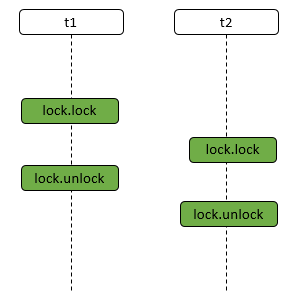
说明:首先线程t1先执行lock.lock操作,然后t2执行lock.lock操作,然后t1执行lock.unlock操作,最后t2执行lock.unlock操作。基于这样的时序,分析AbstractQueuedSynchronizer内部的工作机制。
① t1线程调用lock.lock函数,其函数调用顺序如下,只给出了主要的函数调用。
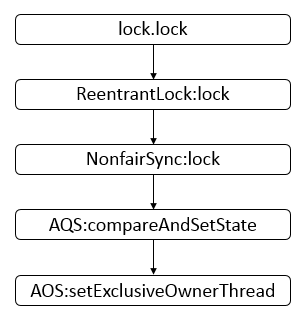
说明:其中,前面的部分表示哪个类,后面是具体的类中的哪个方法,AQS表示AbstractQueuedSynchronizer类,AOS表示AbstractOwnableSynchronizer类。
② t2线程调用lock.lock函数,其函数调用顺序如下,只给出了主要的函数调用。
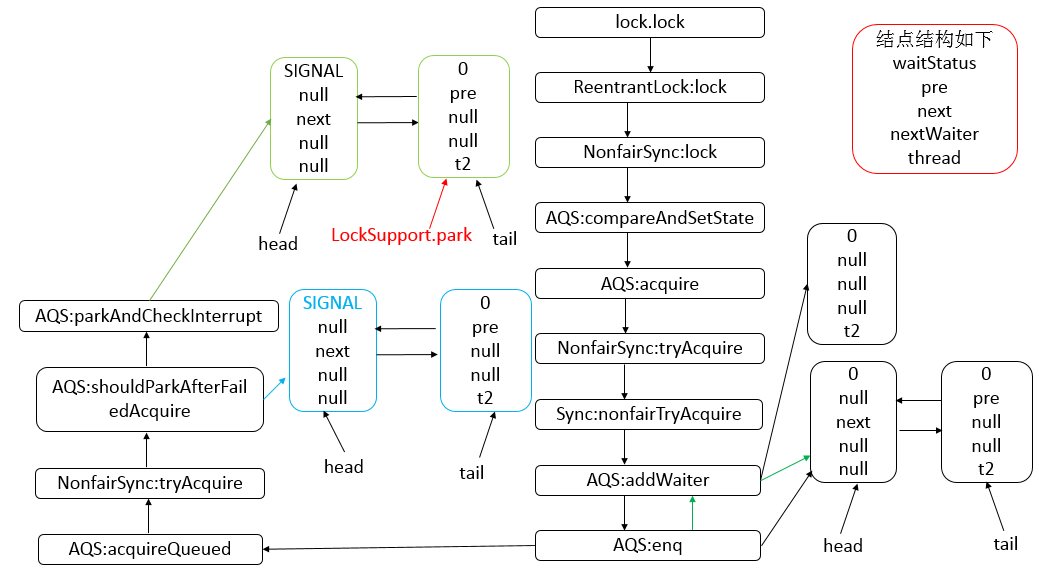
说明:经过一系列的函数调用,最后达到的状态是禁用t2线程,因为调用了LockSupport.lock。
③ t1线程调用lock.unlock,其函数调用顺序如下,只给出了主要的函数调用。
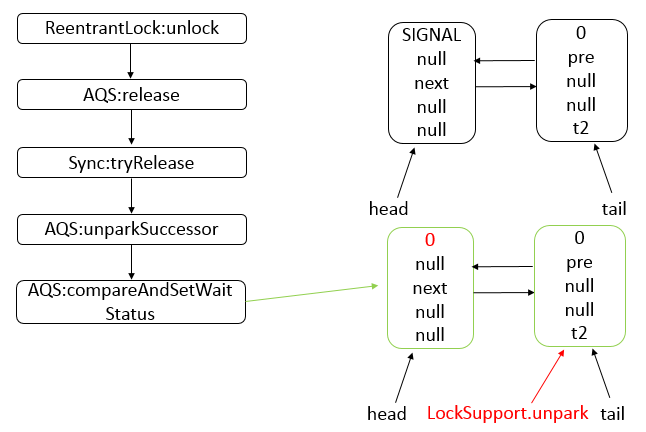
说明:t1线程中调用lock.unlock后,经过一系列的调用,最终的状态是释放了许可,因为调用了LockSupport.unpark。这时,t2线程就可以继续运行了。此时,会继续恢复t2线程运行环境,继续执行LockSupport.park后面的语句,即进一步调用如下。
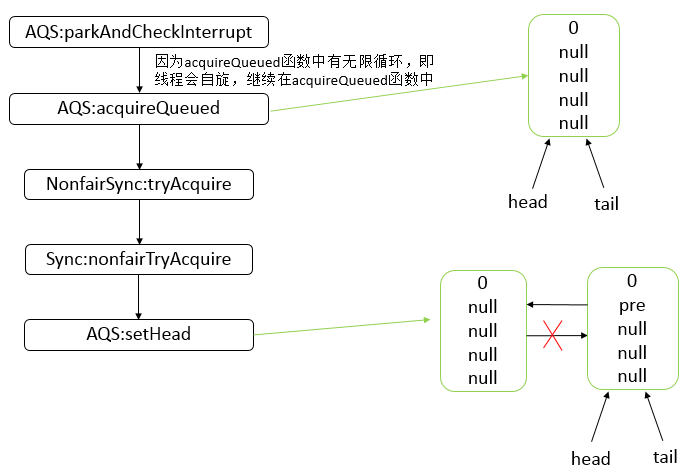
说明:在上一步调用了LockSupport.unpark后,t2线程恢复运行,则运行parkAndCheckInterrupt,之后,继续运行acquireQueued函数,最后达到的状态是头结点head与尾结点tail均指向了t2线程所在的结点,并且之前的头结点已经从sync队列中断开了。
④ t2线程调用lock.unlock,其函数调用顺序如下,只给出了主要的函数调用。
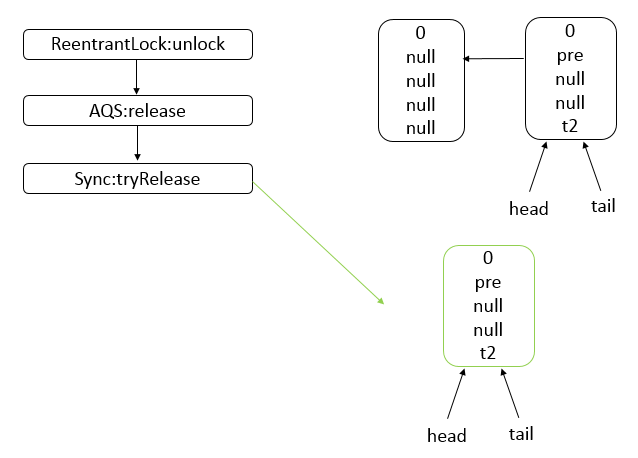
说明:t2线程执行lock.unlock后,最终达到的状态还是与之前的状态一样。
示例二
下面我们结合Condition实现生产者与消费者,来进一步分析AbstractQueuedSynchronizer的内部工作机制。
Depot(仓库)类
package com.hust.grid.leesf.reentrantLock;
import java.util.concurrent.locks.Condition;
import java.util.concurrent.locks.Lock;
import java.util.concurrent.locks.ReentrantLock;
public class Depot {
private int size;
private int capacity;
private Lock lock;
private Condition fullCondition;
private Condition emptyCondition;
public Depot(int capacity) {
this.capacity = capacity;
lock = new ReentrantLock();
fullCondition = lock.newCondition();
emptyCondition = lock.newCondition();
}
public void produce(int no) {
lock.lock();
int left = no;
try {
while (left > 0) {
while (size >= capacity) {
System.out.println(Thread.currentThread() + " before await");
fullCondition.await();
System.out.println(Thread.currentThread() + " after await");
}
int inc = (left + size) > capacity ? (capacity - size) : left;
left -= inc;
size += inc;
System.out.println("produce = " + inc + ", size = " + size);
emptyCondition.signal();
}
} catch (InterruptedException e) {
e.printStackTrace();
} finally {
lock.unlock();
}
}
public void consume(int no) {
lock.lock();
int left = no;
try {
while (left > 0) {
while (size <= 0) {
System.out.println(Thread.currentThread() + " before await");
emptyCondition.await();
System.out.println(Thread.currentThread() + " after await");
}
int dec = (size - left) > 0 ? left : size;
left -= dec;
size -= dec;
System.out.println("consume = " + dec + ", size = " + size);
fullCondition.signal();
}
} catch (InterruptedException e) {
e.printStackTrace();
} finally {
lock.unlock();
}
}
}
测试类
package com.hust.grid.leesf.reentrantLock;
class Consumer {
private Depot depot;
public Consumer(Depot depot) {
this.depot = depot;
}
public void consume(int no) {
new Thread(new Runnable() {
@Override
public void run() {
depot.consume(no);
}
}, no + " consume thread").start();
}
}
class Producer {
private Depot depot;
public Producer(Depot depot) {
this.depot = depot;
}
public void produce(int no) {
new Thread(new Runnable() {
@Override
public void run() {
depot.produce(no);
}
}, no + " produce thread").start();
}
}
public class ReentrantLockDemo {
public static void main(String[] args) throws InterruptedException {
Depot depot = new Depot(500);
new Producer(depot).produce(500);
new Producer(depot).produce(200);
new Consumer(depot).consume(500);
new Consumer(depot).consume(200);
}
}
运行结果(可能的一种):
produce = 500, size = 500
Thread[200 produce thread,5,main] before await
consume = 500, size = 0
Thread[200 consume thread,5,main] before await
Thread[200 produce thread,5,main] after await
produce = 200, size = 200
Thread[200 consume thread,5,main] after await
consume = 200, size = 0
说明:根据结果,我们猜测一种可能的时序如下
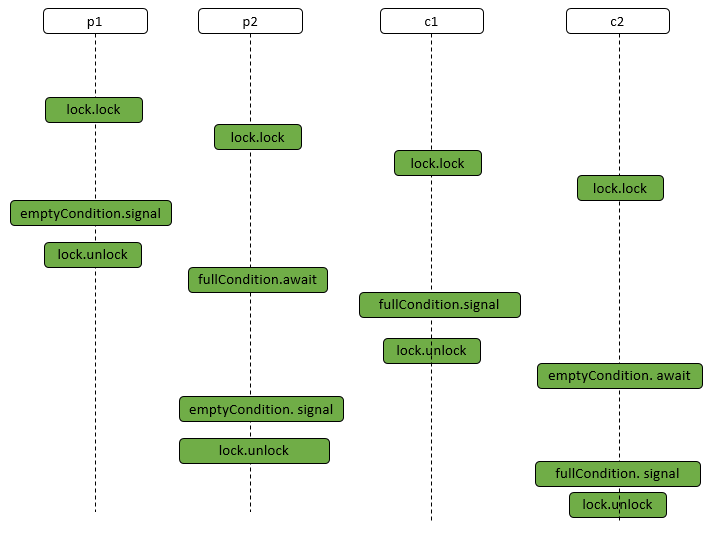
说明:p1代表produce 500的那个线程,p2代表produce 200的那个线程,c1代表consume 500的那个线程,c2代表consume 200的那个线程。
p1线程调用lock.lock,获得锁,继续运行,函数调用顺序在前面已经给出。
p2线程调用lock.lock,由前面的分析可得到如下的最终状态。
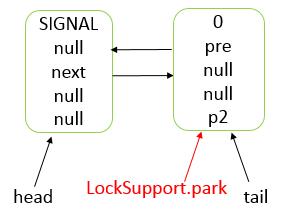
说明:p2线程调用lock.lock后,会禁止p2线程的继续运行,因为执行了LockSupport.park操作。
- c1线程调用lock.lock,由前面的分析得到如下的最终状态。
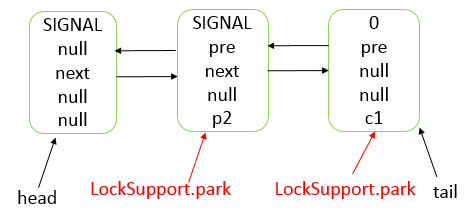
说明:最终c1线程会在sync queue队列的尾部,并且其结点的前驱结点(包含p2的结点)的waitStatus变为了SIGNAL。 4. c2线程调用lock.lock,由前面的分析得到如下的最终状态。
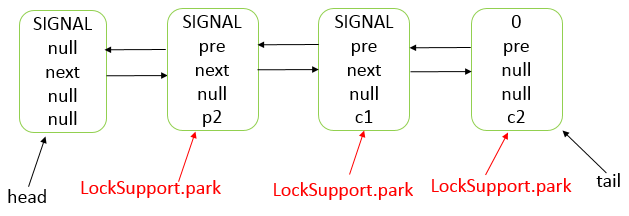
说明:最终c1线程会在sync queue队列的尾部,并且其结点的前驱结点(包含c1的结点)的waitStatus变为了SIGNAL。
- p1线程执行emptyCondition.signal,其函数调用顺序如下,只给出了主要的函数调用。
说明:AQS.CO表示AbstractQueuedSynchronizer.ConditionObject类。此时调用signal方法不会产生任何其他效果。
- p1线程执行lock.unlock,根据前面的分析可知,最终的状态如下。
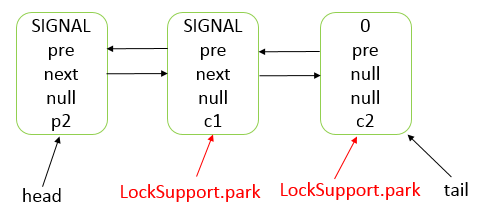
说明:此时,p2线程所在的结点为头结点,并且其他两个线程(c1、c2)依旧被禁止,所以,此时p2线程继续运行,执行用户逻辑。
- p2线程执行fullCondition.await,其函数调用顺序如下,只给出了主要的函数调用。
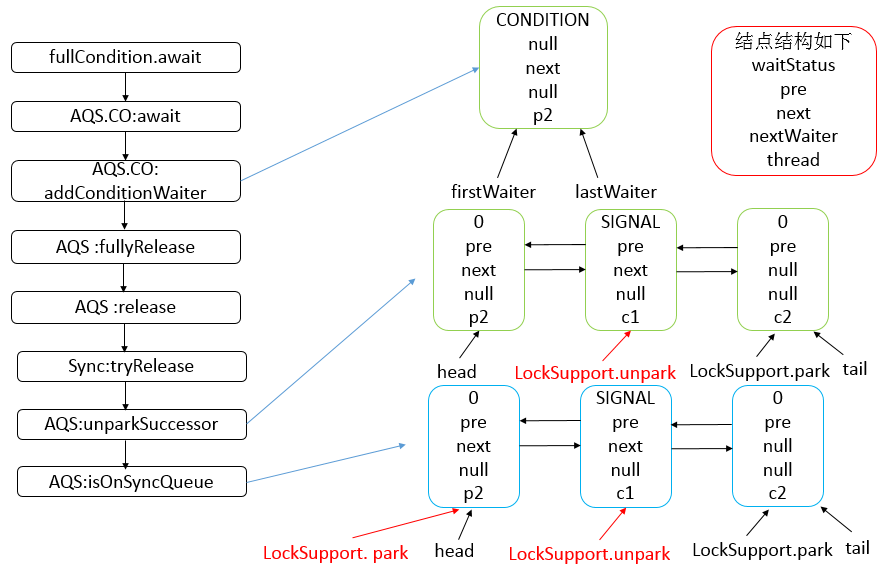
说明:最终到达的状态是新生成了一个结点,包含了p2线程,此结点在condition queue中;并且sync queue中p2线程被禁止了,因为在执行了LockSupport.park操作。从函数一些调用可知,在await操作中线程会释放锁资源,供其他线程获取。同时,head结点后继结点的包含的线程的许可被释放了,故其可以继续运行。由于此时,只有c1线程可以运行,故运行c1。
- 继续运行c1线程,c1线程由于之前被park了,所以此时恢复,继续之前的步骤,即还是执行前面提到的acquireQueued函数,之后,c1判断自己的前驱结点为head,并且可以获取锁资源,最终到达的状态如下。
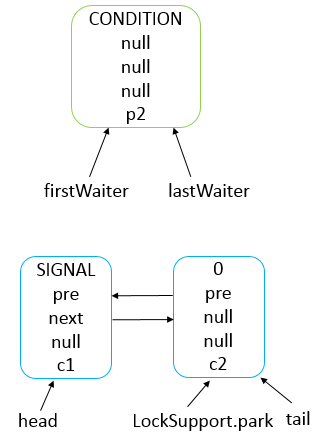
说明:其中,head设置为包含c1线程的结点,c1继续运行。
- c1线程执行fullCondtion.signal,其函数调用顺序如下,只给出了主要的函数调用。
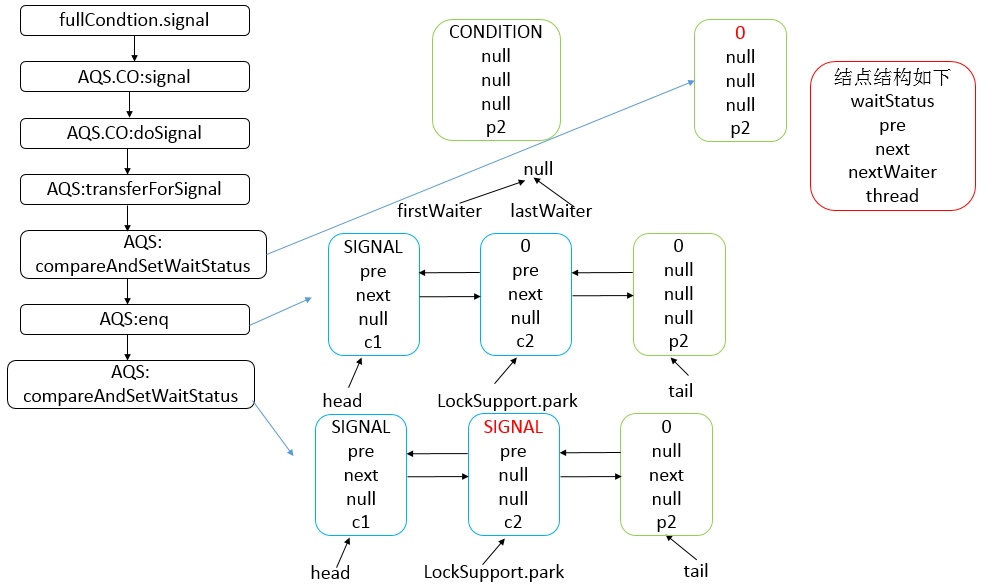
说明:signal函数达到的最终结果是将包含p2线程的结点从condition queue中转移到sync queue中,之后condition queue为null,之前的尾结点的状态变为SIGNAL。
- c1线程执行lock.unlock操作,根据之前的分析,经历的状态变化如下。
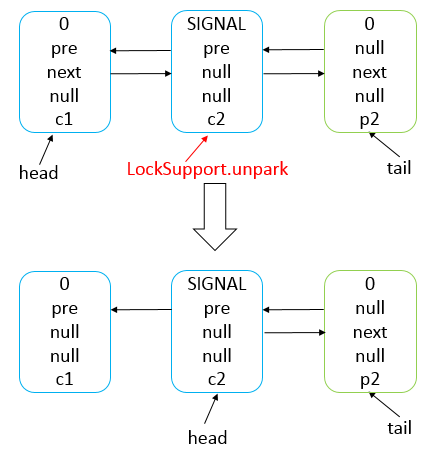
说明:最终c2线程会获取锁资源,继续运行用户逻辑。
- c2线程执行emptyCondition.await,由前面的第七步分析,可知最终的状态如下。
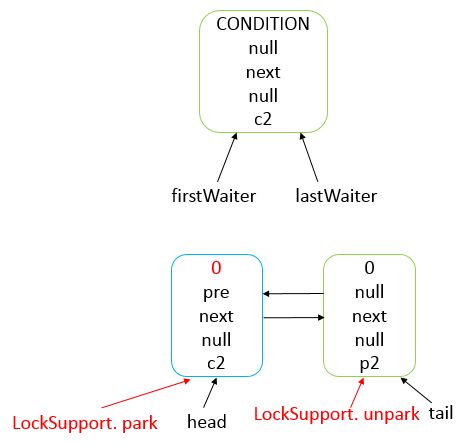
说明:await操作将会生成一个结点放入condition queue中与之前的一个condition queue是不相同的,并且unpark头结点后面的结点,即包含线程p2的结点。
- p2线程被unpark,故可以继续运行,经过CPU调度后,p2继续运行,之后p2线程在AQS:await函数中被park,继续
AQS.CO:await函数的运行,其函数调用顺序如下,只给出了主要的函数调用。
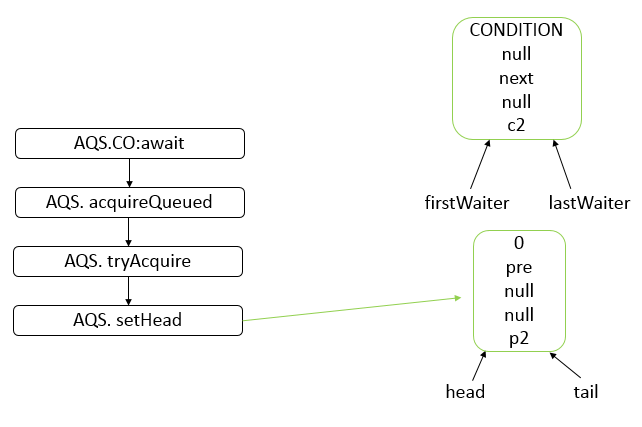
- p2继续运行,执行emptyCondition.signal,根据第九步分析可知,最终到达的状态如下。
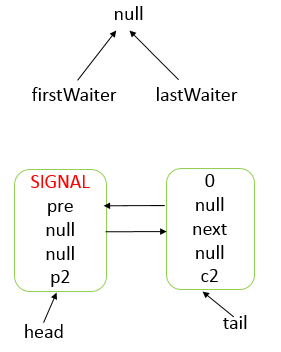
说明:最终,将condition queue中的结点转移到sync queue中,并添加至尾部,condition queue会为空,并且将head的状态设置为SIGNAL。
- p2线程执行lock.unlock操作,根据前面的分析可知,最后的到达的状态如下。
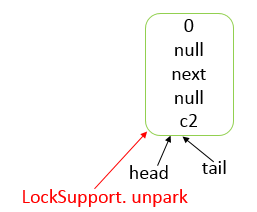
说明:unlock操作会释放c2线程的许可,并且将头结点设置为c2线程所在的结点。
c2线程继续运行,执行fullCondition. signal,由于此时fullCondition的condition queue已经不存在任何结点了,故其不会产生作用。
c2执行lock.unlock,由于c2是sync队列中最后一个结点,故其不会再调用unparkSuccessor了,直接返回true。即整个流程就完成了。
总结
对于AbstractQueuedSynchronizer的分析,最核心的就是sync queue的分析。
① 每一个结点都是由前一个结点唤醒
② 当结点发现前驱结点是head并且尝试获取成功,则会轮到该线程运行。
③ condition queue中的结点向sync queue中转移是通过signal操作完成的。
④ 当结点的状态为SIGNAL时,表示后面的结点需要运行。
当然,此次分析没有涉及到中断操作,如果涉及到中断操作,又会复杂得多,以后遇到这种情况,我们再进行详细分析,AbstractQueuedSynchronizer类的设计令人叹为观止,以后有机会还会进行分析。也谢谢各位园友的观看~
引用资料
- http://ifeve.com/introduce-abstractqueuedsynchronizer/
- http://blog.csdn.net/chen77716/article/details/6641477
- https://www.cnblogs.com/leesf456/p/5350186.html
